|
|
Parts
and accessories part 2 |
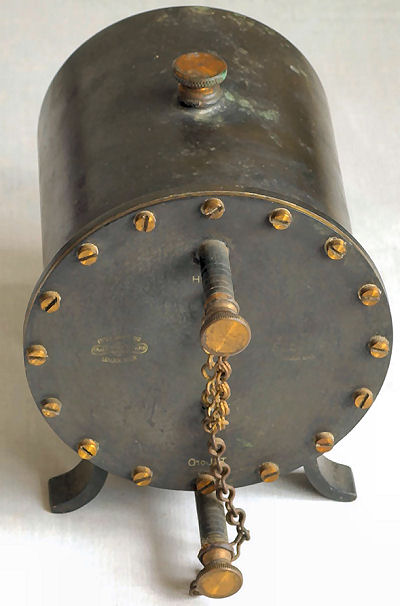 |
Ether Saturator for magic lantern limelight. A device made by Wrench, used to produce a substitute for hydrogen gas for limelight illuminants by mixing ether and oxygen. Stands 5.5 inches high. |
Lime light lamp.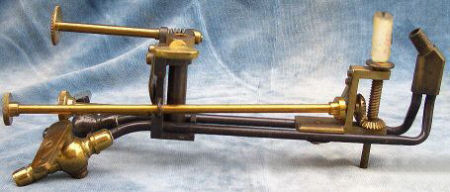 This lime light burner is signed at the rear KERSHAW'S PATENT, W.I.CHADWICK MANCHESTER. These, and many other sources of light used in magic lanterns you will find here: Light in the darkness. The development of light sources for the magic lantern. |
|
|
Magic lantern microscope attachment. Interesting device which attaches to a magic lantern for projecting microscope slides. By this means an object can be conveniently examined by several people at once, and can be drawn or traced very easily. At the end of the 19th century microscope attachments were made by many of the scientific lantern makers. There is no manufacturers name on this item but the objective is made by J. Swift & Son, London. Box Size : 11 x 7.25 x 5.5 inches (28 x 18,5 x 14 cm). |
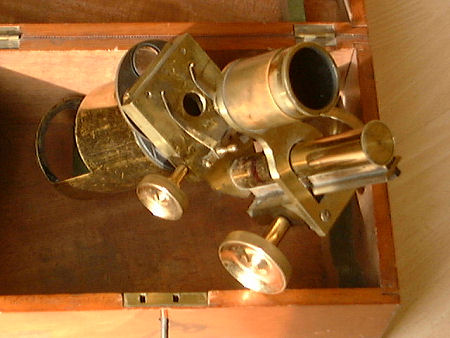
|
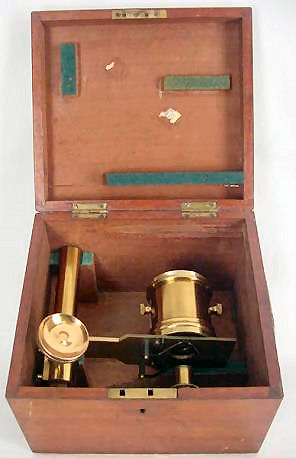 |
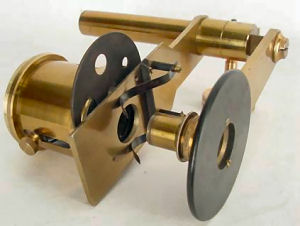 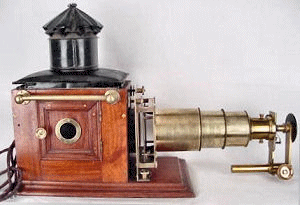 |
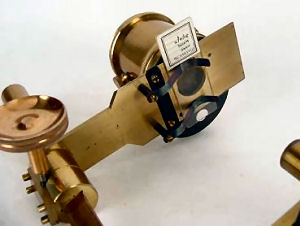 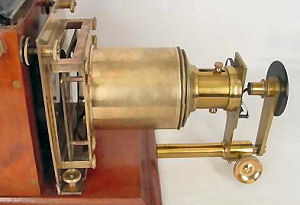 |
|
Another interesting device for projecting microscope
slides in a wooden chest. It could replace the normal projection lens of a
magic lantern. The manufacturer is unknown. |
||
Chemical tank.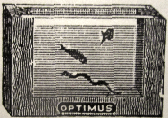 Device made for the purpose of demonstrating simple chemical experiments
on the screen. The Animalculae or chemical tank made by Perken, Son &
Rayment (trade mark Optimus) has a mahogany frame with rectangular
openings in which two glass plates separated by a piece of India rubber
are inserted. The tank was placed in the lantern stage, where the lantern
slide is ordinarily put. By mixing some liquids in the tank, the chemical reactions
could be observed on the screen.
Device made for the purpose of demonstrating simple chemical experiments
on the screen. The Animalculae or chemical tank made by Perken, Son &
Rayment (trade mark Optimus) has a mahogany frame with rectangular
openings in which two glass plates separated by a piece of India rubber
are inserted. The tank was placed in the lantern stage, where the lantern
slide is ordinarily put. By mixing some liquids in the tank, the chemical reactions
could be observed on the screen.The projection of small live creatures was another use of the tank slide. |
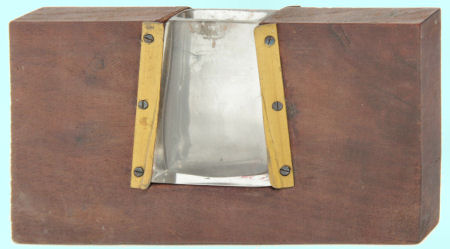 Wooden frame in which a glass container is placed that can be filled with water or another liquid. |
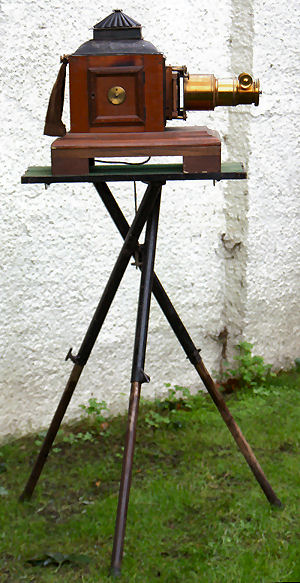 |
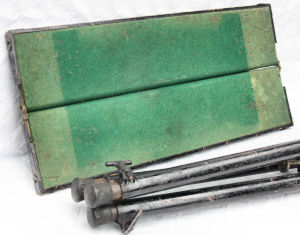 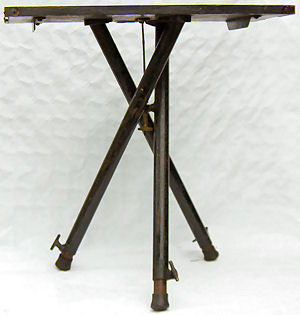 |
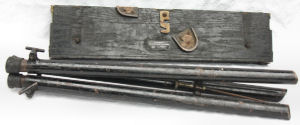 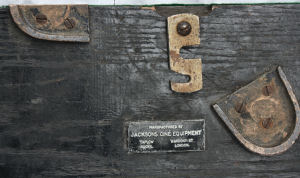 Vintage projector stand/tripod, very solid and sturdy. Made by Jacksons, London.  Platform when open is 28.5 x 62 cm approx. Height when legs extended approx 105 cm. |
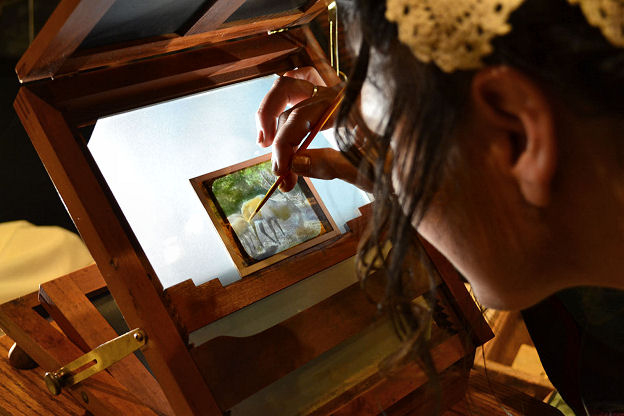 |
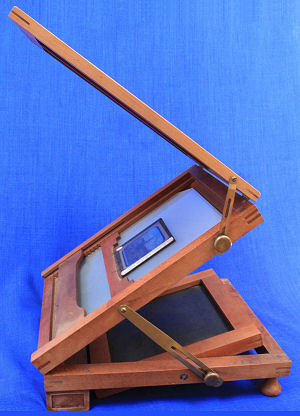 |
|
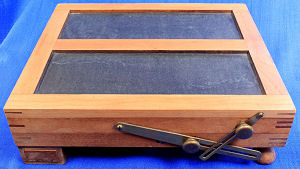 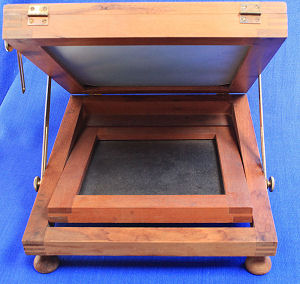 |
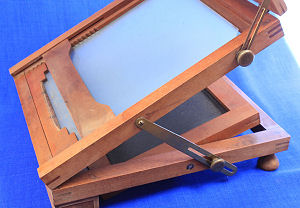 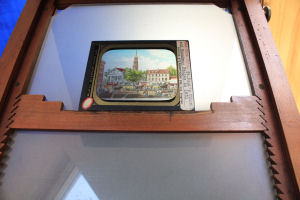 |
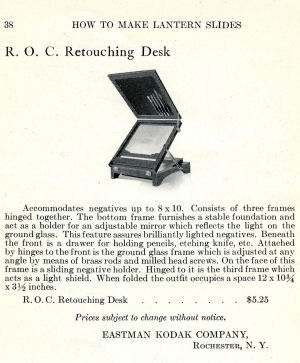 Magic lantern Slide Colorist's Desk |
|
This retouching desk consists of three hardwood frames
hinged together with brass hardware. The bottom frame provides a stable
foundation and acts as a holder for an adjustable black matte surface, which
allows diffused light to be reflected on the ground glass held in the middle
frame. It is on this ground glass that the lantern slide is supported and
tinted. The upper frame serves to shade the ground from ambient light.
Beneath the front of the base is a drawer holding pencils, etching knife,
etc. Attached by brass hinges to the front is the ground glass frame, which
is adjusted at any angle by means of brass sliding struts and milled head
screws. An adjustable support for the glass lantern slide is found on the
front surface of the ground glass. When folded this tinting desk occupies a
space of 12" x 10.75" x 3.5" (c. 30.5 x 27.5 x 9 cm). (Also see: Painting and colouring the magic lantern slides) |
||
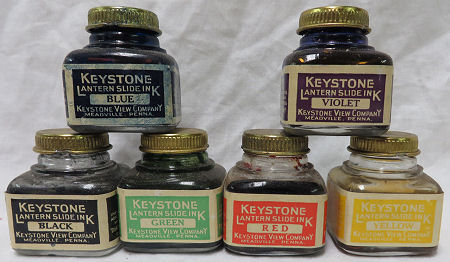 |
Six jars of Keystone Lantern slide ink. Part of the
"Outfit For Making Homemade Lantern Slides", manufacturer Keystone View Co.
Meadville, Pennsylvania. For tinting and colouring the magic lantern slides a lot of inks, crayons, and paints were available. (Also see: Painting and colouring the magic lantern slides) |
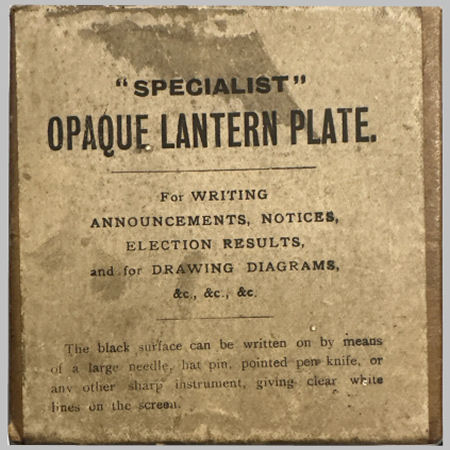 |
Cardboard box containing Opaque lantern plates for writing announcements, notices, election results, and for drawing diagrams, etc. |
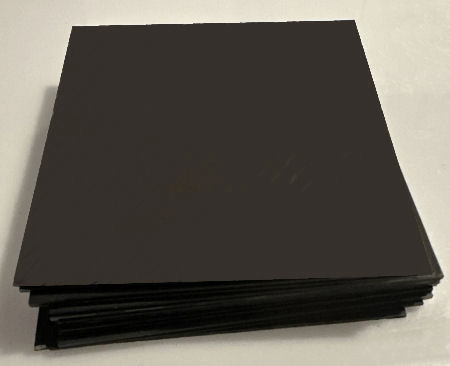 |
|
|
The black surface can be written on by means of a large
needle, hat pin, pointed pen, knife, or any other sharp instrument, giving clear
white lines on the screen. |
|
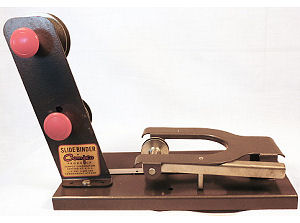 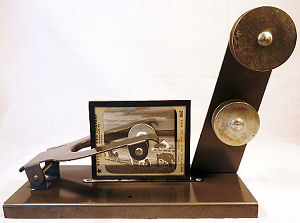 |
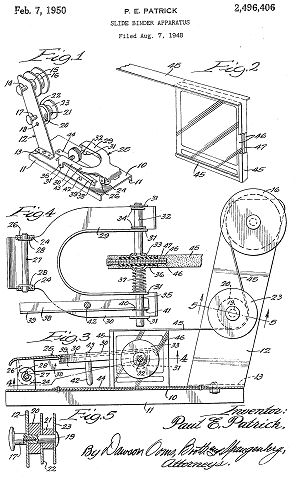 |
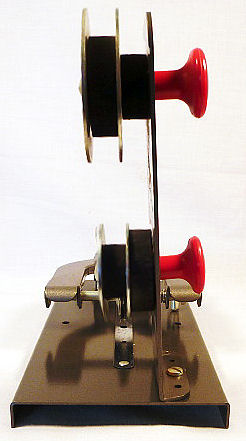 Compco Slide Binder. |
|
Advertised as speedily and accurately tapes protective
cover glass onto slides. It sizes 2" x 2" to 3 1/4" x 4" (c. 5 x 5 tot 8 x
25 cm). In the centre the patent application dd. august 7, 1948. |
||
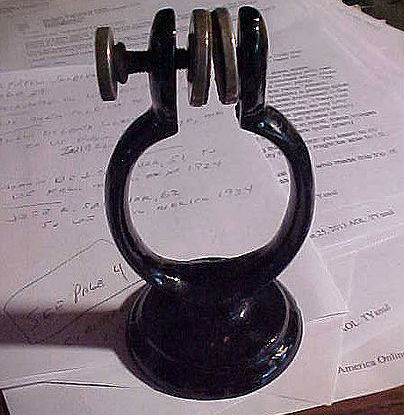 |
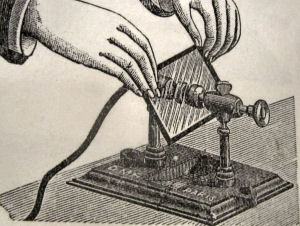 |
|
Vintage slide binder. The two glasses of the slide and possibly a paper mat between them are placed between the screws and tightened together. Then you simply rotate the item to apply binding tape. Made of cast iron. |
|
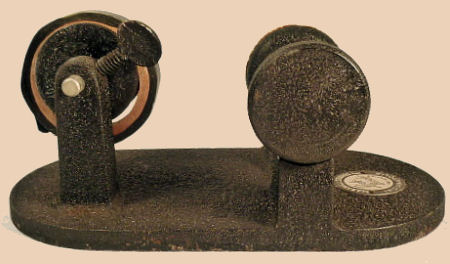 This magic lantern slide binder is made by Marshall Studios Inc. of Indianapolis between 1938 and 1941. |
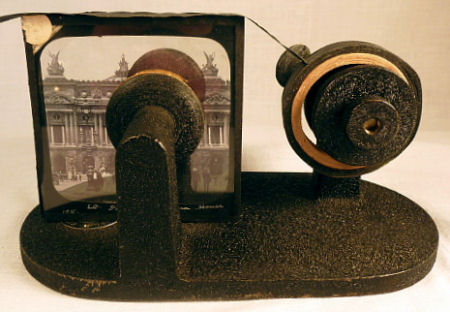 |
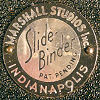 To protect transparencies from smearing, staining, or
moisture damage, this slide binder has a device which allows the cover glass
and image glass to rest on the base of binder to maintain exact alignment of
edges while tape is being applied. To protect transparencies from smearing, staining, or
moisture damage, this slide binder has a device which allows the cover glass
and image glass to rest on the base of binder to maintain exact alignment of
edges while tape is being applied. |
|
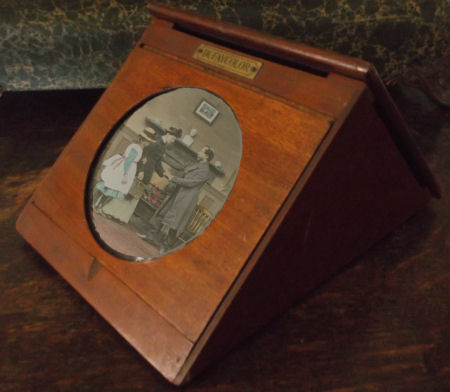 Wooden slide viewer. |
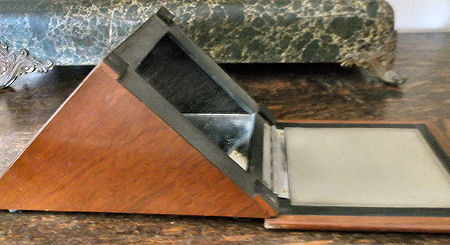 A wooden glass mirrored slide viewer made by Dufaycolor. There is a 4.5" square frosted glass slide in the recess at the hinged back, and a mirror at the bottom that reflects the slide that is viewed.  |
 |
Magic lantern slide binding
strips. Sticky tape for joining the two glasses
of a lanternslide. |
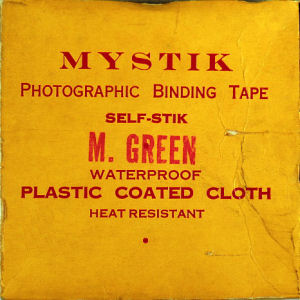 |
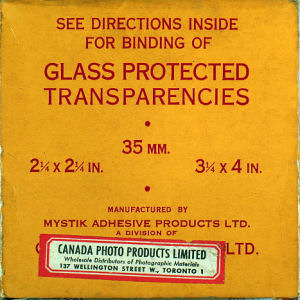 |
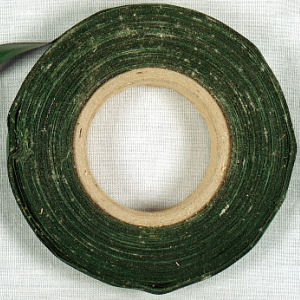 |
 Box is 4" square x ¾" thick (10 cm x 10 cm x 2 cm). |
Cardboard box with a roll of green waterproof and washable Mystik Photographic Binding Tape for glass protected transparencies (magic lantern slides). Below are the original directions. Suggestion for other uses on the back of the direction page include “repairing holes in bellows of cameras and enlargers, and using the slide binding tape in different colors to denote different topics of slides. | |
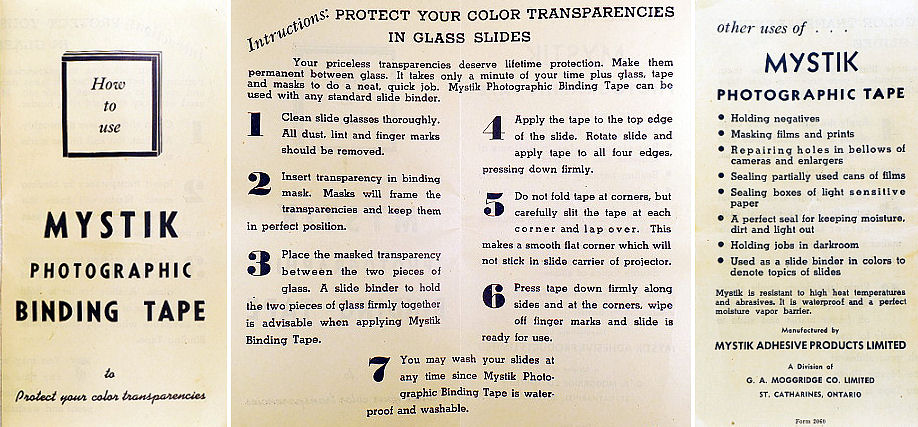 |
||
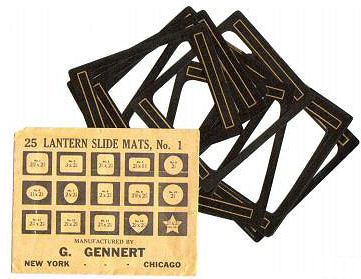 |
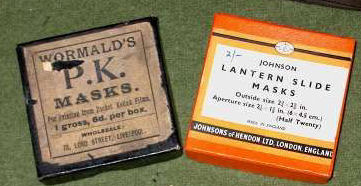 |
 |
Slide masks or mats. Paper frames to enclose within the cover glass and the image glass of a slide. When slides were no longer mounted in wooden frames, but simply edge-bound with a cover glass, often such a mat, made of thin black or white opaque paper, was placed between the two glasses. Apertures of various shapes and sizes were available. They served to exclude extraneous details at the edge and also to mask the shortcomings of cheaper lenses which tended to soft focus towards the end of the picture. |
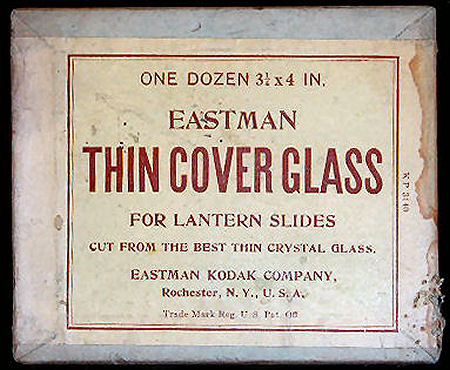 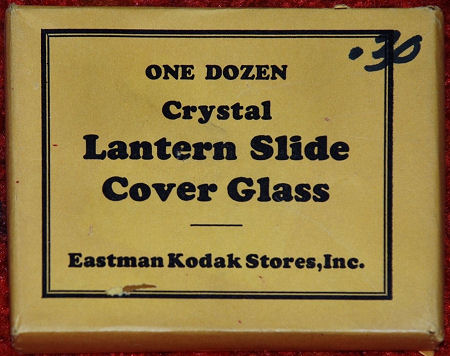 |
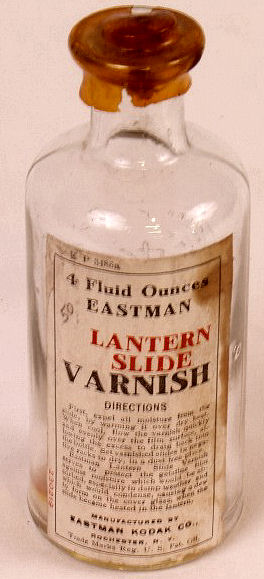 Two ways to protect the vulnerable magic lantern slides. a. By means of thin cover glasses. A cardboard box containing twelve thin glasses 'cut from the best thin crystal glass', and a paper packet of one dozen cover glasses, both made by the Eastman Kodak Company. b. By a thin layer of varnish. At the right a fluid varnish, also from Eastman Kodak. |
|
More accessories..... |
|
| |
©1997-2024 'de Luikerwaal' All rights reserved. Last update: 16-10-2024. |